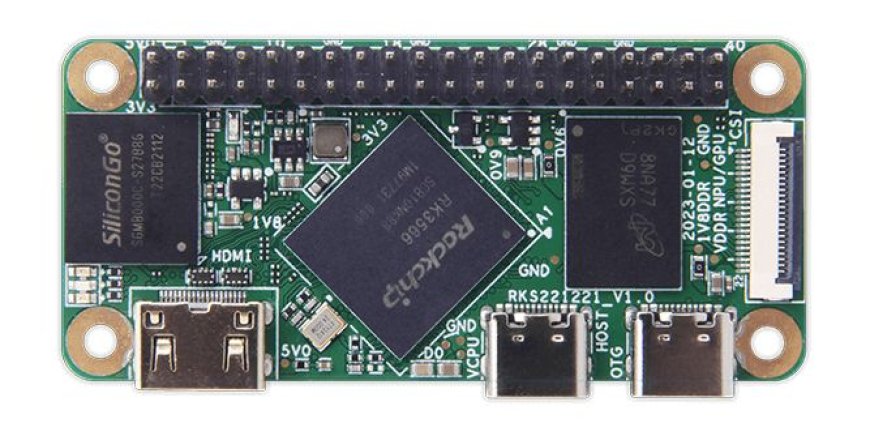Geniatech XPI-3566-Zero: A Raspberry Pi Zero Challenger
The Raspberry Pi Zero 2 W garnered much attention upon its release, but its availability was often elusive, leaving enthusiasts in pursuit of alternatives. One notable concern with the Zero 2 W was its limited RAM, featuring a mere 512MB of LPDDR. To address this gap in performance, Geniatech introduced the XPI-3566-Zero, a board powered by the RK3566 chipset, boasting a quad-core Arm Cortex A55 processor clocked at 1.8 GHz. What sets this board apart from the Raspberry Pi ecosystem is its flexibility in terms of RAM and eMMC storage options, ranging from 512MB to 8GB of RAM and 8GB to 128GB of eMMC storage. In this comprehensive review, we'll evaluate the Geniatech XPI-3566-Zero, focusing on its potential as an alternative to the Raspberry Pi Zero 2 W and its ability to deliver the performance boost many enthusiasts desire.

Unveiling the Geniatech XPI-3566-Zero
Let's begin by taking a closer look at the Geniatech XPI-3566-Zero, a promising contender in the single-board computer (SBC) landscape.
Also check New AMD Threadripper Pro CPU breaks cinebench records
RAM and Storage Options
The Geniatech XPI-3566-Zero offers a range of configurations to cater to diverse user needs. Users can select from RAM options ranging from 512MB to a generous 8GB. Similarly, eMMC storage options vary from 8GB to 128GB. The review unit we have on hand is equipped with 2GB of RAM and 8GB of eMMC storage, which is available at an approximate retail price of $31. For those seeking a bit more power, the 4GB RAM and 32GB eMMC model can be acquired for around $43.
A Familiar Form Factor
The XPI-3566-Zero inherits a form factor strikingly similar to the Raspberry Pi Zero. This design choice enables it to serve as a potential drop-in replacement for those using the Raspberry Pi Zero W, albeit with a few distinctions. Notably, the XPI-3566-Zero lacks a micro SD card slot, opting for USB-C ports instead of traditional USB ports.
Benchmarks and Performance Evaluation
To gauge the XPI-3566-Zero's viability as an alternative to the Raspberry Pi Zero 2 W and its capacity to deliver enhanced performance, we subjected it to rigorous benchmarking and testing.
CPU Power: RK3566 on Display
The Geniatech XPI-3566-Zero is powered by the RK3566 chipset, featuring a quad-core Arm Cortex A55 processor clocked at 1.8 GHz. This processor offers a noteworthy boost in processing power compared to the Raspberry Pi Zero 2 W. While the Raspberry Pi Zero 2 W was constrained by its 512MB of LPDDR RAM, the Geniatech board's flexibility allows users to choose configurations with up to 8GB of RAM. This additional RAM capacity significantly contributes to the XPI-3566-Zero's ability to handle resource-intensive tasks and multitasking with ease.
Storage Options: eMMC Advantage
The inclusion of eMMC storage on the XPI-3566-Zero further enhances its performance capabilities. Unlike traditional micro SD cards, eMMC storage offers faster read and write speeds, resulting in quicker boot times and improved overall system responsiveness. Users can select from a range of eMMC storage options, tailoring their choice to suit their storage requirements.
Form Factor Familiarity
The XPI-3566-Zero closely emulates the Raspberry Pi Zero's form factor, making it an appealing choice for those accustomed to the Raspberry Pi ecosystem. Its compatibility with existing cases, accessories, and projects adds to its convenience as a potential replacement for the Raspberry Pi Zero W.
Prospects and Considerations
As we evaluate the Geniatech XPI-3566-Zero's performance, it's evident that it offers a compelling alternative to the Raspberry Pi Zero 2 W. The enhanced processing power, coupled with flexible RAM and eMMC storage options, positions it as a versatile and capable SBC. Additionally, its form factor familiarity simplifies the transition for Raspberry Pi enthusiasts.
Ideal User Scenarios
The XPI-3566-Zero caters to a range of user scenarios. It excels in applications that demand increased processing power and multitasking capabilities, making it suitable for tasks such as media streaming, retro gaming emulation, and IoT projects. Users can select the RAM and eMMC storage configurations that align with their specific project requirements.
USB-C Ports and No Micro SD Slot
While the XPI-3566-Zero's USB-C ports offer advantages in terms of modern connectivity, users accustomed to traditional USB ports may need to adapt or utilize adapters. The absence of a micro SD card slot may also require users to rely on eMMC storage or external USB storage options.
Conclusion: A Compelling Alternative with Power and Flexibility
In conclusion, the Geniatech XPI-3566-Zero stands as a robust contender in the SBC arena, presenting a formidable alternative to the Raspberry Pi Zero 2 W. Its RK3566 chipset delivers impressive processing power, while the flexibility in RAM and eMMC storage options allows users to tailor the board to their project needs. The familiar form factor, reminiscent of the Raspberry Pi Zero, ensures a seamless transition for Raspberry Pi enthusiasts.
Ultimately, the XPI-3566-Zero's combination of power, flexibility, and versatility makes it a noteworthy choice for a wide range of applications. Whether you require enhanced multitasking capabilities, accelerated media streaming, or robust IoT project performance, the Geniatech XPI-3566-Zero emerges as a compelling and accessible solution.


































